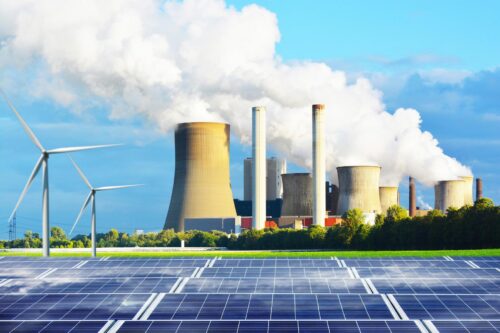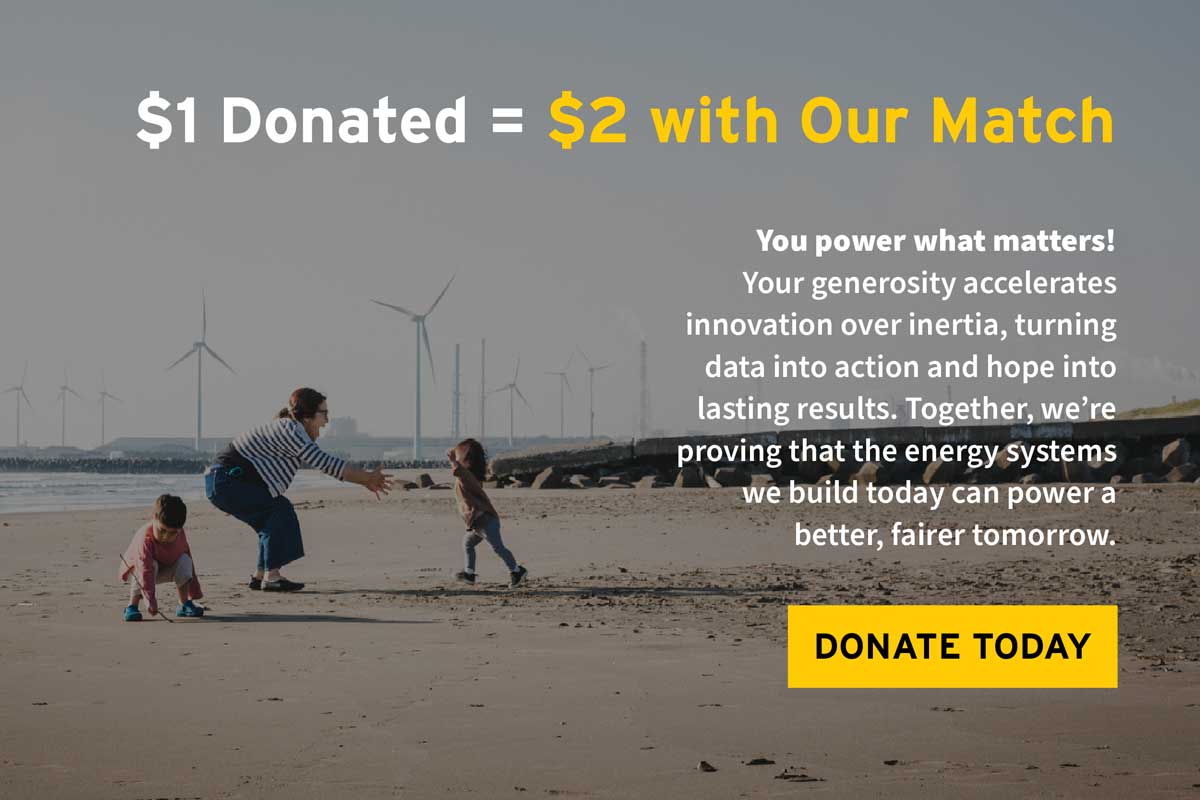
The State of Utility Planning, 2025 Q1
US electric utility IRP updates in Q1 2025 saw an increase in gas capacity additions, and a decrease in wind and solar, compared with our Q4 2024 update due to projected load growth from data centers and capacity accreditation considerations.
This article is one of a series in our review of all integrated resource plans (IRPs) for electric utilities across the United States. We provide analysis of expected load, planned capacity, modeled generation and emissions, and comparison to targets and decarbonization scenarios to evaluate progress toward a zero-carbon energy future.
Every month, RMI’s Engage & Act team quantitatively reviews integrated resource plans (IRPs) to identify which US electric utilities are on track to achieve adequate progress on emissions reductions, and which utilities have plans that do not move quickly enough. IRPs do not provide a fully accurate prediction of the future, but we focus on them because they reflect the direction that utilities are currently striving for and a set of proposed actions to get there.
Updates in Q1 2025
In our previous review of utility IRPs at the end of 2024, we observed less load growth than in prior quarters with higher emissions driven by more than 12 GW of gas plant additions by 2035 and 20 GW less wind and solar capacity over the same timeframe. Despite the noise, the industry’s longer-term trends of increasing load growth, growing additions of clean resources, and lower projected emissions relative to history continued.
In this most recent first quarter of 2025, utilities that updated their IRPs saw a big jump in projected load (+6.0 percent) with +7.4 percent higher emissions relative to prior plans. Additional gas capacity additions to meet this higher load was driven in part by capacity accreditation considerations and some limits on wind and solar additions applied as model constraints.
For this review of Q1 2025, we also made an update to the International Energy Agency’s Net Zero by 2050 Scenario (IEA NZE) — updating from the World Energy Outlook 2023 to World Energy Outlook 2024. This updated scenario has less emissions reduction by 2030 because of a later start to emissions reductions in historical data and assumes higher load growth (+51 percent vs. +41 percent for the period 2023–2035). Three additional small IRPs were added to the dataset and we made a modest update in how we forecast usage of flexible generation resources.
Load growth and the way this growth is being met in IRPs continues to evolve. This quarter provides a snapshot of the challenge the electric sector faces — increasing forecasted load continuing to pressure climate ambitions. However, the opportunity exists to meet this growing demand with clean resources in ways that can achieve climate success while managing affordability. More work needs to be done across the sector, and we still need many more utilities to increase their climate ambitions, become climate leaders, and capture the upsides of the growth opportunity that the clean energy transition represents.
The current state of IRPs
In our current snapshot of IRPs (Exhibit 1), we continue to see a gap between projected emissions, target emissions, and decarbonization pathways such as the International Energy Agency’s Net Zero Emissions by 2050 Scenario (IEA NZE).
Most decarbonization pathways, including the IEA NZE, find that the electricity sector needs to reach net-zero emissions by 2035. Unfortunately, utility company targets often aim for net-zero emissions by 2050, and often do not comprehensively cover emissions from both owned (Scope 1) and purchased (Scope 3) emissions. If all companies in our coverage meet their targets, they will only reduce their emissions 64 percent by 2035, compared to a 2005 baseline. We also find a gap between these targets and projected emissions based on IRPs, which as of Q1 2025 we project to be reduced by just 54 percent by 2035, compared to a 2005 baseline.
Exhibit 1
Load
As of Q1 of 2025, IRPs across the United States anticipate load to grow 22 percent by 2035 compared to 2023 levels (Exhibit 2). This is up from prior projections — 12 percent at the end of 2023, 8 percent in August 2022, and 6 percent in January 2021.
Load growth continues to be a critical concern for many utilities, as current load projections continue to show strong growth with each update. In Q1 2025 we observe an increase in projected load in IRPs at the second-highest level since our data coverage began in 2021.
Utilities that updated their IRPs in Q1 2025 forecasted electricity demand growth driven primarily by demand from data centers and industrial manufacturing. Emerging electricity demand from electric vehicles and space heating continue to be monitored and discussed in IRPs but are still generally a smaller source of load growth in the near term.
Exhibit 2
Capacity
Current planned capacity in IRPs across the United States (Exhibit 3) includes 262 GW of wind and solar additions, 94 GW of gas additions, and 74 GW of coal retirements between 2023 and 2035.
Updates to capacity plans in Q1 2025 continue the trend of the past several quarters of increasing planned gas additions. Current plans for 94 GW of additions by 2035 are 10 GW higher than was planned at the end of Q4 2024, and 34 GW higher than was planned at the end of 2023.
Unlike our observation at Q4 2024 about scaled down planned wind and solar capacity additions, we now observe an additional 2 GW of planned wind and solar capacity by 2035.
With these recent changes, plans indicate there will be 40 GW more gas than wind and solar in 2035. This is a stark contrast to our Q2 2024 IRP review, in which planned wind and solar capacity in 2035 nearly exceeded planned gas capacity.
Utilities that increased planned gas capacity in Q1 2025 cited several reasons for their changes. These included changing capacity accreditation rules and reserve margins in MISO and SPP, modeling limits on wind and solar additions, and strict reliability needs of data centers or other customers. However, numerous studies have also demonstrated that a cost-effective, reliable grid is ideally made up primarily of zero-carbon energy sources, with gas acting in a minor, secondary role. There remains a large opportunity for utilities to invest more in clean energy for the benefit of their customers, investors, and the climate.
Exhibit 3
Emissions
Our latest projections (Exhibit 4) are that emissions planned in IRPs at the end of Q1 2025 will be 54 percent lower than 2005 levels by 2035. This is a smaller reduction than we projected from IRPs at the end of 2023, when emissions planned in IRPs showed a 60 percent reduction, and the end of 2024 when the figure was 56 percent.
Projected emissions by 2035 remain lower than they were at the beginning of 2021 because of increased overall plans to build zero-carbon capacity. However, projected emissions are higher now than at the end of 2023 and 2024 because of delays or reductions to planned zero-carbon capacity additions and increased use of gas.
Exhibit 4
Cumulative metrics
When considering climate alignment of the US electricity sector, or individual utilities, the key metric that RMI’s Engage & Act platform focuses on is cumulative emissions through 2035. Cumulative emissions, or the total amount of greenhouse gases put into the atmosphere, is what directly influences climate change, so this metric gives us clear insight into whether we are on track to meet climate goals. We also find value in metrics of cumulative projected load, to know whether the task of reducing emissions is becoming easier or more difficult for utilities, and cumulative projected emissions intensity, to know if consumers are increasing or decreasing emissions associated with their electricity consumption.
Exhibit 5 shows that across all IRPs in the United States, cumulative projected emissions are 7 percent higher, cumulative projected load is 4 percent higher, and cumulative projected emissions intensity is 3 percent higher now at the end of Q1 2025 compared to the end of 2023.
Utilities that were more successful at limiting or reducing future emissions often did so by considering a complete set of options for providing reliable electricity to customers, including demand-side management and energy storage as a complement to wind and solar power while limiting gas capacity additions.
Exhibit 5
Exhibit 6 provides an additional view of the direction that IRPs are going, by considering the percent change in cumulative projected load and emissions among the set of companies that did update their IRPs each quarter. These utilities expect load growth in their service territories at the highest level we’ve seen since the same quarter of 2024 and the second-highest level we’ve seen going back to the middle of 2021. However, the utilities this quarter also increased projected emissions (and emissions intensity) by 7.4 percent, a result of updates to IRPs that reduced planned wind and solar capacity and increased planned gas capacity and generation.
Exhibit 6
Achieving a climate-aligned future
Our review of IRP updates in Q1 2025 revealed individual utility success stories, but also concerning recent trends in how utilities are navigating this critical moment of the clean energy transition. With strong load growth, many utilities plan to add more gas capacity instead of adding to their near-term plans to build wind and solar capacity, due to interconnection difficulties, changing capacity accreditation rules, and strict reliability needs for new electricity demand. Because of these both real and perceived barriers to zero-carbon energy deployment, we observed an increase in planned gas capacity and generation, resulting in a 7 percent increase in cumulated projected emissions from 2023 through 2035 relative to the end of 2023.
We will continue to monitor the trends that emerge as IRPs are updated throughout the rest of 2025. Regional variations and company-specific choices will continue to play an important role in the progress of the sector, as will broader economy-wide policy, regulation, and market trends. RMI’s docket opportunity tracker provides insight into key upcoming proceedings where important planning decisions will be made.
With this view to the future, we still see a significant opportunity for more utilities to become leaders in the clean energy transition. By fully taking advantage of IRA incentives, utilizing novel approaches to meeting large loads such as Power Couples, clean repowering, and planning more comprehensively, utilities can reduce emissions, provide reliable and low-cost electricity to customers, and generate increasing earnings for investors.
RMI’s Engage & Act Platform: Data and Insights for Real Climate Impact
RMI’s Engage & Act Platform provides data and insights for real climate impact. To learn how you can access and use this targeted resource to uncover recent trends and clean energy growth opportunities — and accelerate the pace of electric utility carbon emissions reductions — please visit the Engage & Act website.
Methodology
Historical data in this article comes from the RMI Utility Transition Hub. Projected capacity and total generation (load) is based on data collected manually from IRPs by EQ Research, combined with historical data. Generation by technology is calculated with assumed continuation of trends in capacity factor for each company and technology, and converted to emissions by using average US emissions factors by technology.
